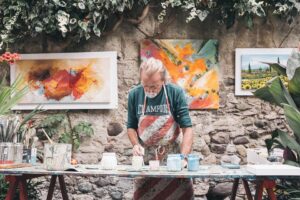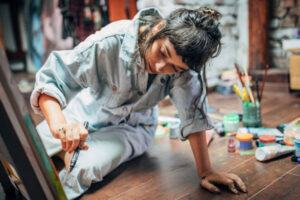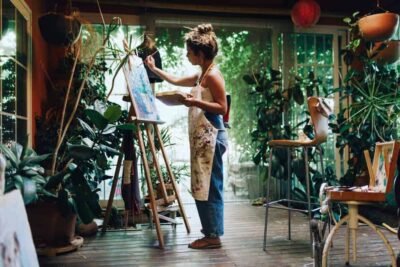Art history essay topics offer a rich tapestry of subjects that delve into the evolution, context, and impact of art across different periods and cultures. Exploring these topics allows students and scholars to engage with the intricate connections between art and the societal, political, and technological forces that shaped its creation and reception.
From the classical masterpieces of ancient civilizations to the avant-garde movements of the 20th century, art history essay topics can uncover the layers of meaning and influence behind various artistic expressions.
Whether examining the symbolism in Renaissance paintings, the revolutionary techniques of Impressionism, or the cultural significance of indigenous art forms, these topics provide a comprehensive understanding of how art reflects and influences the human experience.
Choosing the right Art history essay topics

Choosing the right topic for an art history essay is crucial to ensuring that your essay is engaging, insightful, and manageable within the scope of your assignment. Here are some strategies and tips to help you select an appropriate and compelling topic:
1. Interest and Passion
Choose a topic that genuinely interests you. Your passion for the subject will translate into more engaging writing and thorough research.
2. Course Relevance
Ensure the topic aligns with the themes and periods covered in your course. This will provide a solid foundation of knowledge to build upon.
3. Specificity
Narrow your focus to a specific artist, artwork, period, or movement. Broad topics can be overwhelming and difficult to cover comprehensively.
4. Research Resources
Verify the availability of sufficient resources. Ensure there are enough scholarly articles, books, and other references available to support your research.
5. Originality
Look for unique angles or lesser-explored topics. Originality can make your essay stand out and contribute new insights to the field.
6. Complexity and Scope
Assess the complexity and scope of the topic. It should be complex enough to challenge you but not so broad that it becomes unmanageable.
Potential Art History Essay Topics:
1. Analysis of Specific Artworks
- The symbolism in Leonardo da Vinci’s “The Last Supper.”
- The use of light and shadow in Caravaggio’s “The Calling of St. Matthew.”
- Interpretation of color in Vincent van Gogh’s “Starry Night.”
2. Art Movements and Styles
- The influence of Impressionism on modern art.
- The evolution of Abstract Expressionism.
- The impact of the Renaissance on European art.
3. Artists and Their Influence
- The contributions of Frida Kahlo to feminist art.
- The role of Pablo Picasso in the development of Cubism.
- Banksy’s influence on contemporary street art.
4. Cultural and Historical Context
- The role of art in the French Revolution.
- Egyptian art and its significance in ancient society.
- The reflection of political themes in Mexican muralism.
5. Thematic Studies
- Representations of women in medieval art.
- The portrayal of war in 20th-century art.
- Religious symbolism in Byzantine mosaics.
6. Techniques and Materials
- The development and impact of oil painting in the Renaissance.
- The use of fresco techniques in Italian art.
- Innovations in sculpture during the Baroque period.
7. Comparative Studies
- Comparing the depiction of nature in Chinese and Japanese art.
- Differences between Northern and Italian Renaissance art.
- Contrasting modernist architecture with traditional architectural styles.
8. Modern and Contemporary Issues
- The role of digital media in contemporary art.
- The influence of globalization on art trends.
- The intersection of art and technology in installations.
Tips for Writing:
- Thesis Statement: Develop a clear and concise thesis statement that outlines the main argument or perspective of your essay.
- Structured Outline: Create an outline to organize your main points and supporting arguments logically.
- Critical Analysis: Engage in critical analysis rather than mere description. Discuss the significance, context, and impact of the artwork or movement.
- Visual Analysis: Include detailed visual analysis if relevant, discussing composition, technique, and style.
- Citation and References: Use proper citation methods to reference all sources accurately, adhering to the required academic style guide.
By following these guidelines and selecting a well-defined, interesting topic, you can craft an engaging and insightful art history essay.
300 Art history essay topics

Here’s an extensive list of 300 art history essay topics organized by various categories to help you find a compelling subject for your essay:
Analysis of Specific Artworks
- The Mona Lisa by Leonardo da Vinci
- The Last Supper by Leonardo da Vinci
- The Starry Night by Vincent van Gogh
- Guernica by Pablo Picasso
- The Persistence of Memory by Salvador Dalí
- The Birth of Venus by Sandro Botticelli
- The School of Athens by Raphael
- The Arnolfini Portrait by Jan van Eyck
- The Garden of Earthly Delights by Hieronymus Bosch
- The Night Watch by Rembrandt
- The Scream by Edvard Munch
- The Creation of Adam by Michelangelo
- Girl with a Pearl Earring by Johannes Vermeer
- American Gothic by Grant Wood
- Liberty Leading the People by Eugène Delacroix
- The Kiss by Gustav Klimt
- Whistler’s Mother by James McNeill Whistler
- The Hay Wain by John Constable
- The Swing by Jean-Honoré Fragonard
- Les Demoiselles d’Avignon by Pablo Picasso
Art Movements and Styles
- The Renaissance: Origins and Impact
- The Baroque Era: Characteristics and Key Figures
- Neoclassicism: Revival of Classical Art
- Romanticism: Emotion and Individualism
- Realism: Depicting Everyday Life
- Impressionism: Light and Color
- Post-Impressionism: Beyond Impressionism
- Fauvism: Bold Colors and Brushwork
- Cubism: Breaking Down Forms
- Surrealism: Dreams and Reality
- Abstract Expressionism: Emotions on Canvas
- Pop Art: Celebrating Popular Culture
- Dadaism: Art as Protest
- Futurism: Movement and Modernity
- Minimalism: Less is More
- Art Nouveau: Beauty in Design
- Art Deco: Elegance and Glamour
- Symbolism: Beyond Reality
- Constructivism: Art for a New Society
- Op Art: Optical Illusions
Artists and Their Influence
- Leonardo da Vinci: Renaissance Genius
- Michelangelo: Sculptor and Painter
- Raphael: Master of the High Renaissance
- Vincent van Gogh: Post-Impressionist Visionary
- Pablo Picasso: Pioneer of Cubism
- Rembrandt: Master of Light and Shadow
- Claude Monet: Father of Impressionism
- Georgia O’Keeffe: Mother of American Modernism
- Frida Kahlo: Icon of Feminism
- Jackson Pollock: Abstract Expressionist
- Andy Warhol: Pop Art Leader
- Salvador Dalí: Surrealist Master
- Henri Matisse: Color and Composition
- Wassily Kandinsky: Abstract Pioneer
- Diego Rivera: Mexican Muralist
- Caravaggio: Baroque Innovator
- Edvard Munch: Expressionist Icon
- Paul Cézanne: Bridge to Modernism
- Joan Miró: Surrealism and Beyond
- Banksy: Street Art and Anonymity
Cultural and Historical Context
- Art of Ancient Egypt: Symbols and Beliefs
- Greek Art: Classical Ideals
- Roman Art: Innovation and Legacy
- Byzantine Art: Religious Iconography
- Medieval Art: Faith and Function
- Gothic Art: Height and Light
- The Italian Renaissance: Revival of Antiquity
- The Northern Renaissance: Detail and Realism
- Baroque Art in Europe: Power and Drama
- Rococo Art: Playfulness and Extravagance
- Neoclassical Art: Return to Order
- Romantic Art: Emotion and Nature
- Realist Art: Honesty and Grit
- Impressionist Art: Capturing the Moment
- Post-Impressionist Art: New Directions
- The Harlem Renaissance: African American Art
- Mexican Muralism: Social and Political Commentary
- Soviet Art: Propaganda and Innovation
- Art in Nazi Germany: Control and Censorship
- Contemporary Art: Global Perspectives
Thematic Studies
- Depictions of Women in Art
- Representations of War in Art
- The Role of Religion in Art
- Portraiture: Identity and Status
- Landscape Art: Nature and Place
- Still Life: Symbolism and Technique
- Mythology in Art
- Political Art: Protest and Power
- Urbanization and Art
- The Body in Art: Form and Function
- Art and Technology: Changing Perspectives
- Environmental Art: Nature and Activism
- Public Art: Accessibility and Impact
- Art and Identity: Race, Gender, and Sexuality
- Fantasy and Imagination in Art
- Art and Death: Mourning and Memory
- Art and Education: Learning through Visuals
- Cultural Heritage and Art Conservation
- The Role of Patronage in Art
- The Evolution of Artistic Techniques
Techniques and Materials
- Fresco Painting: From Antiquity to Renaissance
- Oil Painting: Development and Impact
- Watercolor Techniques: Transparency and Layering
- Sculpture: Materials and Methods
- Printmaking: Techniques and Innovations
- Collage: Assembling Art
- Digital Art: New Frontiers
- Mixed Media: Combining Techniques
- Encaustic Painting: Ancient Technique Revived
- Mosaic Art: Patterns and Materials
- Stained Glass: Light and Color
- Textile Art: Weaving and Embroidery
- Ceramic Art: Pottery and Sculpture
- Photography as Art: Development and Impact
- Installation Art: Space and Experience
- Performance Art: Live Expression
- Street Art: Graffiti to Galleries
- Body Art: Tattoos and Beyond
- Calligraphy: Art of Beautiful Writing
- Architecture: Form and Function
Comparative Studies
- Italian vs. Northern Renaissance Art
- Baroque Art in Italy vs. Spain
- Impressionism vs. Post-Impressionism
- Abstract Expressionism vs. Minimalism
- Western vs. Eastern Art Traditions
- Greek vs. Roman Sculpture
- Byzantine vs. Gothic Art
- Realism vs. Romanticism
- Modernism vs. Postmodernism
- Classical vs. Contemporary Art
Modern and Contemporary Issues
- The Role of Women in Contemporary Art
- Art and Globalization
- Digital Revolution in Art
- The Impact of Social Media on Art
- Environmental Themes in Modern Art
- Art as Political Protest in the 21st Century
- The Influence of Popular Culture on Art
- Contemporary Street Art: Beyond Banksy
- Art and Mental Health Awareness
- The Art Market: Auctions and Galleries
Art in Various Cultures
- African Tribal Art: Traditions and Techniques
- Japanese Ukiyo-e: Floating World Prints
- Chinese Calligraphy: Art and Language
- Indian Miniature Paintings: Detail and Devotion
- Native American Art: Symbols and Stories
- Oceanic Art: Ritual and Symbolism
- Islamic Art: Geometry and Calligraphy
- Pre-Columbian Art: Mesoamerica and the Andes
- Aboriginal Australian Art: Dreamtime and Symbols
- Southeast Asian Art: Diversity and Tradition
Art and Society
- Art in the Age of Exploration
- Art and the Industrial Revolution
- The Role of Art in Revolution
- Art during the Great Depression
- Art and the Civil Rights Movement
- Art and Feminism: From Suffrage to Today
- The Influence of Art in Political Campaigns
- Art as Therapy and Healing
- Art in the Digital Age: NFTs and Beyond
- The Future of Museums in a Digital World
Iconic Artworks and their Impact
- The Sistine Chapel Ceiling by Michelangelo
- The Raft of the Medusa by Théodore Géricault
- Olympia by Édouard Manet
- The Gates of Hell by Auguste Rodin
- Nighthawks by Edward Hopper
- A Sunday Afternoon on the Island of La Grande Jatte by Georges Seurat
- The Death of Marat by Jacques-Louis David
- Water Lilies series by Claude Monet
- Campbell’s Soup Cans by Andy Warhol
- The Great Wave off Kanagawa by Hokusai
Art Theory and Criticism
- Formalism in Art
- Iconography: Interpreting Symbols
- Feminist Art Criticism
- Postcolonial Perspectives in Art
- Psychoanalytic Approaches to Art
- Marxist Art Criticism
- Structuralism and Semiotics in Art
- Deconstruction in Art Criticism
- Phenomenology in Art
- Aesthetics: Philosophy of Art
Art and Innovation
- The Development of Perspective in Art
- The Use of Light and Shadow in Art
- Innovations in Printmaking Techniques
- The Evolution of Artistic Materials
- Digital Art: Tools and Techniques
- The Impact of Photography on Painting
- 3D Printing in Sculpture
- Virtual Reality in Art
- Interactive Art: Viewer Participation
- Art and Artificial Intelligence
Art and Emotion
- The Expression of Sorrow in Art
- The Representation of Joy in Art
- Fear and Anxiety in Surrealist Art
- The Depiction of Love in Renaissance Art
- Anger and Protest in Modern Art
- Tranquility in Landscape Painting
- Melancholy in Symbolist Art
- Humor and Satire in Art
- The Sublime in Romantic Art
- The Role of Empathy in Art
Art and Identity
- Self-Portraits: Exploring Identity
- The Representation of LGBTQ+ Themes in Art
- Cultural Identity in Art
- The Portrayal of Gender Roles in Art
- The Concept of the “Other” in Art
- National Identity in Art
- Art and Diaspora: Hybridity and Belonging
- Indigenous Identity in Contemporary Art
- Art and Disability: Representation and Inclusion
- Art as a Reflection of Personal Identity
Art in Different Mediums
- Painting: Evolution and Techniques
- Sculpture: Materials and Forms
- Photography: Art and Technology
- Printmaking: History and Methods
- Ceramics: Craft and Art
- Textile Art: Weaving and Patterns
- Performance Art: Live and Ephemeral
- Installation Art: Space and Experience
- Digital Art: Innovation and Creativity
- Mixed Media: Combining Elements
Regional Art Studies
- African Art: Traditions and Modernity
- Japanese Art: From Ukiyo-e to Manga
- Chinese Art: Calligraphy and Painting
- Indian Art: Miniatures and Modernism
- Islamic Art: Geometry and Calligraphy
- Native American Art: Symbols and Stories
- Oceanic Art: Rituals and Beliefs
- Pre-Columbian Art: Mesoamerica and the Andes
- Aboriginal Art: Dreamtime and Symbols
- Southeast Asian Art: Diversity and Tradition
Art and Technology
- The Impact of the Printing Press on Art
- Photography and Its Influence on Art
- The Role of Film in Art
- Digital Revolution in Art: Pros and Cons
- The Use of Lasers in Art Conservation
- The Influence of the Internet on Art
- Virtual Reality and Immersive Art
- 3D Printing in Contemporary Art
- AI and Machine Learning in Art Creation
- Social Media: New Platforms for Art
Art and Economy
- The Art Market: Trends and Changes
- Art Auctions: History and Impact
- The Role of Art Dealers and Galleries
- Art as Investment: Risks and Rewards
- Economic Impact of Art Festivals
- Government Funding for the Arts
- The Economics of Art Fairs
- The Influence of Wealth on Art Patronage
- Art Theft and Its Economic Impact
- The Role of Corporate Sponsorship in Art
Art and Environment
- Environmental Art: Activism and Awareness
- The Use of Natural Materials in Art
- Art Depicting Climate Change
- Eco-Friendly Practices in Art Creation
- Landscape Art: Celebrating Nature
- Urbanization and Its Impact on Art
- Art in National Parks and Public Lands
- Sustainable Art: Concepts and Examples
- The Role of Art in Environmental Education
- The Impact of Pollution on Art Preservation
Art and Education
- Art Education in Schools: Benefits and Challenges
- The Role of Museums in Art Education
- Art Therapy: Healing Through Creativity
- Community Art Projects: Building Connections
- The Importance of Art History Education
- Online Learning and Art Education
- Art Workshops: Hands-On Learning
- The Impact of Art on Child Development
- Art as a Tool for Social Change
- The Role of Art in Cultural Preservation
Iconic Artifacts and Their Stories
- The Rosetta Stone: Deciphering History
- The Terracotta Army: Protecting an Emperor
- The Elgin Marbles: Controversy and Heritage
- The Mask of Tutankhamun: Ancient Egypt’s Legacy
- The Bayeux Tapestry: A Chronicle in Thread
- The Venus of Willendorf: Prehistoric Art
- The Lascaux Cave Paintings: Early Human Expression
- The Parthenon Sculptures: Classical Greek Art
- The Benin Bronzes: Art and Colonialism
- The Easter Island Moai: Mystery and Monuments
Art in Religion and Mythology
- Christian Iconography in Renaissance Art
- Buddhist Art: Symbols and Statues
- Hindu Deities in Indian Art
- Islamic Calligraphy: Art and Worship
- Mythological Themes in Baroque Art
- The Role of Saints in Medieval Art
- Shinto Art in Japanese Culture
- The Depiction of Gods in Ancient Greek Art
- Religious Architecture: Cathedrals and Temples
- The Influence of Religion on Byzantine Art
Art and Modern Issues
- Art and Mental Health: Exploring Emotions
- The Role of Art in Political Movements
- The Impact of Censorship on Art
- Art and Migration: Stories of Displacement
- The Digital Divide in Art Access
- Art and Gender Equality
- Art in the Age of Pandemic: Adaptations and Innovations
- The Future of Public Art
- Art and Artificial Intelligence: Ethical Considerations
- The Role of Art in Social Justice Movements
These topics cover a wide range of periods, styles, themes, and issues in art history, providing ample options to explore for your essay.
Conclusion
Selecting the right art history essay topic is essential for crafting a compelling and insightful essay. Whether you’re analyzing specific artworks, exploring different art movements, comparing regional styles, or delving into the intersection of art and modern issues, the vast array of subjects in art history offers endless opportunities for research and discovery.
By choosing a topic that aligns with your interests and course objectives, and ensuring there are sufficient resources available, you can create a well-rounded and engaging essay that contributes meaningful perspectives to the field of art history.

